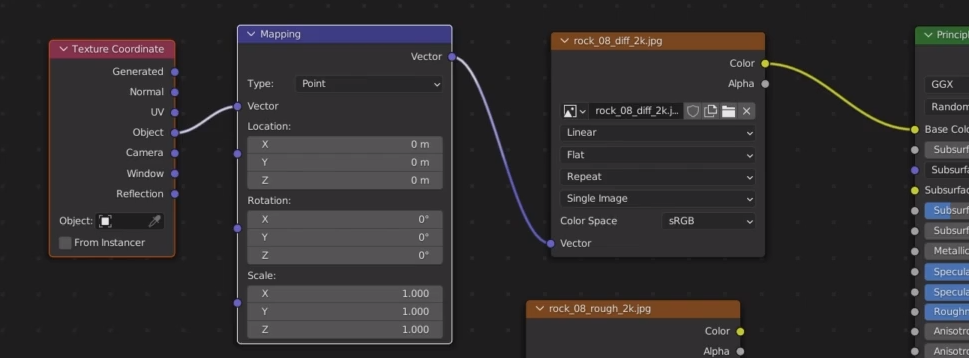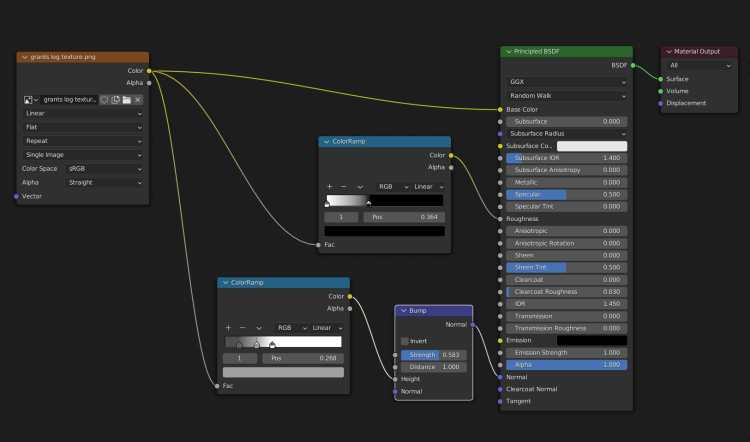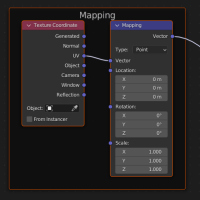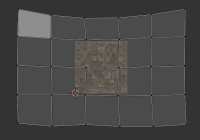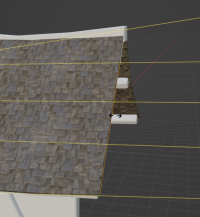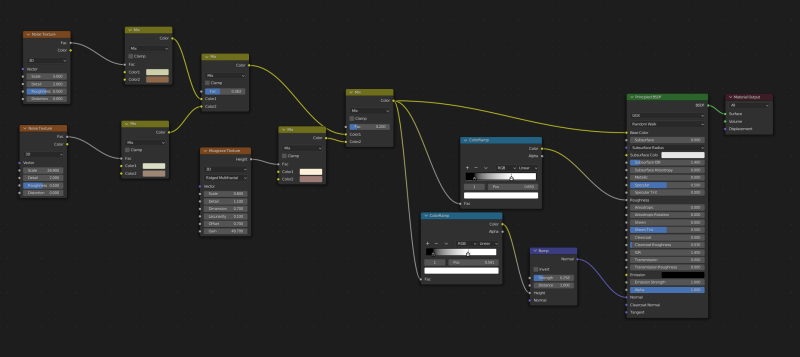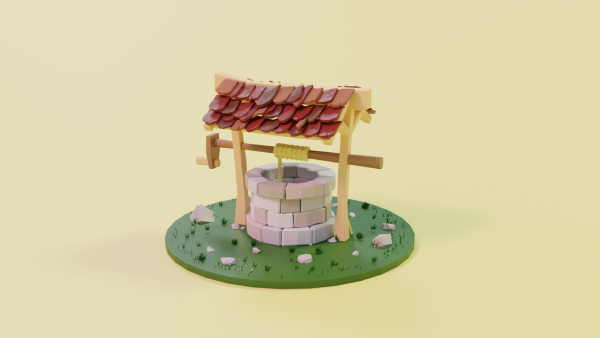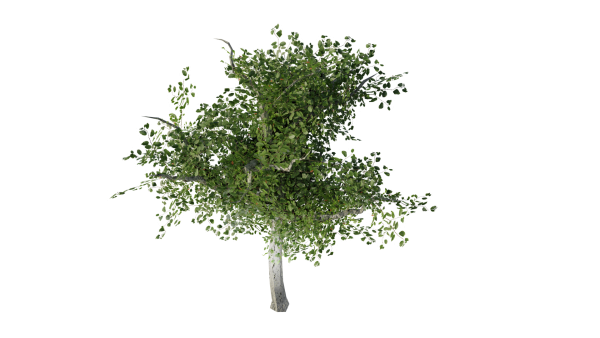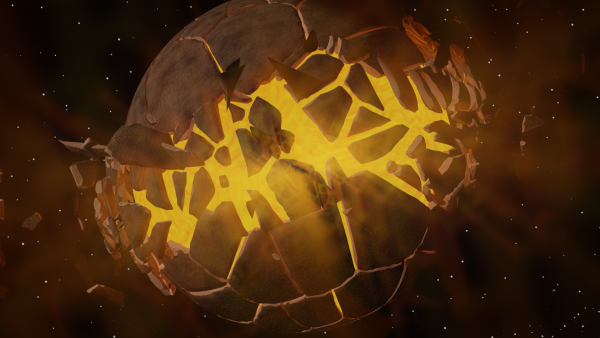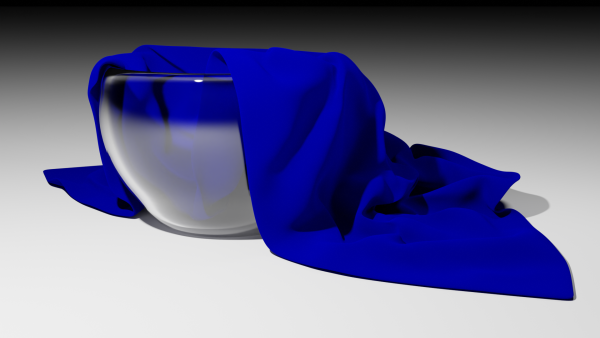This is an old revision of the document!
3D Modeling
This section will document what I wish to keep handy regarding Blender 3D, an advanced and powerful 3D modeling suite. It's free and open source so feel free to rush to their website, download it, and have fun as well.
Texturing
PBR materials
PBR stands for Physically Based Rendering : the materials react to the environment surrounding it in a physically realistic way.
Use Cycles render engine for this.
Texture Coordinates
For all the texture nodes use a Texture coordinate node (use output Object) and a Mapping node (use input Vector). Hook the output Vector of the Mapping into the input Vectors of the each texture images.
If you have Node Wrangler add-on activated, the keyboard shortcut CTRL + T will automatically generate these nodes.
Incidently, using Node Wrangler add-on you can select the Principled BSDF and use CTRL + SHIFT + T to open a bundle of maps and have them set-up as a Principled Texture.
Base Color
Keep the diffuse image in sRGB colorspace but if your mapping on an object use a Box projection instead of Flat.
Roughness
For roughness use Non-Color colorspace and Box projection as well.
Normal
For the normals use Non-Color colorspace and Box projection. Use a Normal map node to convert the output Color to the input Normal of the Principled BSDF
Displacement
The displacement avoids the Principled BSDF and goes directly into the Displacement input of the Material Output. This is because the displacement actually affects the geometry of the object whereas the Principled BSDF affects the way it looks.
Displacement must be activated in the Options under the Surface tab (choose : Displacement and Bump instead of Bump Only)
Displacement works best when there are many polygons on the object (use of a Subdivision Surface modifier is advised) and adds a good bit of detail. The drawback is it takes a lot more processing power and it's use is not advised for games.
Box Projection Method
Box projection has the advatage of being quick to setup, works with modifiers (e.g. bevel) and automatically updates if you modify the shape (e.g. extrude).
However, it does not work with a game engine, which require a proper UV Map (hence, we cannot choose the Object output of the Texture Coordinate Node).
UV Map Method
UV Map on the other hand requires to properly unwrap your object but once textured it can be exported easily to a game engine. The downside is you will see the seams, and there is no way to blend it so you should think carefully about where you place them, and keep your objects at a safe viewing distance. Another inconvenience is that you have to apply the modifiers for the seams to be set properly so it is slightly destructive.
Both these methods however keep the advantage of being able to easily change the PBR texture.
Texture painting
You can also load an image into a texture brush and paint directly on the object. In which case, choosing a random tiling and a large brush along with isolated-click painting instead of strokes can result in a good looking object. One drawback is the object has no roughness and the texture looks a bit flat.
In the case of texture painting, there is a way to add a bit of normals and bumpiness using the data from the image texture and a few color ramps as so :
Texture Atlas
A texture atlas is a custom image combining many different textures all in one image. It has the huge advantage of asking the CPU/GPU to load only one image and pick all the textures for different objects from parts of that image. The inconvenience is that each texture will have a lower pixel resolution (being part of a greater image)
Seamless textures
Using seamless textures is useful as the texture will repeat itself when scaled without it being too noticeable at a glance. However, if you scale too much, a pattern will become visible as the texture repeats itself.
There are two ways to scale :
In the node editor, on the mapping node :
In the UV editor, by scaling the unwrap. This second option is preferable if you are going to export your scene to a game engine as the UV unwrap (and it's scale) will be exported with it.
A handy feature of seamless textures is that they will continue applying if you modify your geometry. One good way to do this is with an edge slide (Shortcut : G + G). If you want to edge slide beyond the existing geometry you need to remove clamping (Shortcut : C while edge-sliding).
Procedural textures
Procedural textures are created by using nodes instead of images or photographs to create a material. Basic texture nodes are mixed together (often with a MixRGB node) and the Color output is then used to give both roughness and normals to the material.
When creating textures with this method it's important to think macro-details and micro-details and mix them together. The Scale value of the basic texture nodes can be used to this effect.
A rapid shortcut to create a mix node is to CTRL + SHIFT + RIGHT-CLICK & DRAG from one node to the other one that you want to mix.
The procedural textures can be very easily tweaked and modified. They do not require much artistic skills as opposed to the creation of textures based on images and photographs (although those are often available for free or a small fee on many platforms online). One downside however is that these textures need to be baked to be exported to a game engine, although that is a minor downside as baking is often required when exporting to game engines anyways.
Scultping
Workflow
Start by remeshing : SHIFT + R to choose voxel size then CTRL + R to remesh.
A handy shortcut to toggle selection between objects in Sculpt Mode is to hover over the object you want to select and then ALT + Q
Face count
A good figure to start sculpting is anywhere in the tens of thousands of faces for small features and hundreds of thousands for large features. For very detailed sculpting, modelers often go into the tens of millions of faces but this does require an adequate machine (High end CPU & GPU and 64 to 128 GB of RAM).
Collection & Links
Appending a file to another allows you to bring in any collections from the original file you want to import from. The collection is brought with all it's objects and is more editable.
Linking on the other hand imports a collection as a single object. Note that the origin point for that object will be the world origin from the original file, so if the collections are not centered on that world origin it will be offset when you link it. Also note that the link is not dynamic so any change made to the object in the original file will not update in the other project until the first one is linked again.
Learning Parts
These are a few 3D models I made following various tutorials to learn Blender.
Low Poly Well
Recap
- Uses a bend modifier to create a circle with basic shapes.
- Uses a nice simple low poly esthetic with bevels and moving a few vertices around
- Shows the use of a lattice to parent an object or group of object to follow modifications made to the lattice (bends and such)
Low Poly Tree
Recap
- Use basic extrude (CTRL + Right Click) in Edit Mode to quickly get trunk and branches
- Use the 'image as plains' addon to create a branch from an image with a transparent background
- Add a particle system to multiply that branch using vertex group to focus it only on the branch and not on trunk + with a lot of random scale/rotate it gives a realistic impression
- Texture the bark of the tree
Cracked Planet
Recap
- Use the cell fracture add-on
- Basic particle system use and how collections work instead of layers with that add-on
- Use basic mix shader materials with voronoi displacements
- Use compositing node with backdrop to use a render image as a ghost to draw gas around the planet
Cloth Simulation
Recap
- Introduces the use of integrated cloth animation to render cloth materials (let it drop and choose the keyframe where you find it to your liking)
- Also uses basic glass materials and basic lighting
